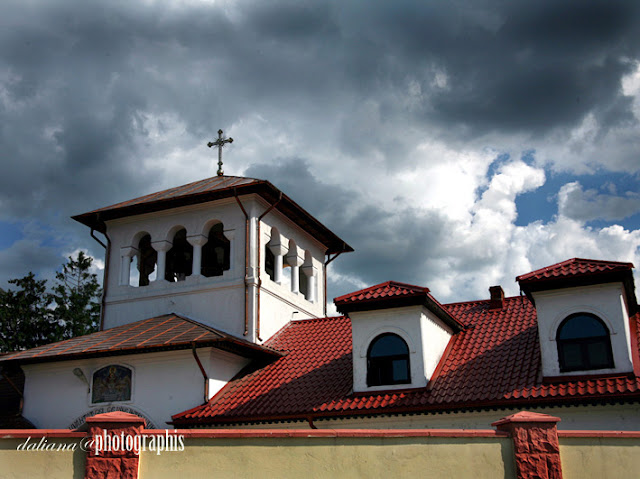The Ghighiu Monastery
The Ghighiu Monastery is located about 5 km away from the city of Ploiesti, in the Barcanesti village. The believers come in large numbers to the monastery, which was originally built in the middle of a forest, to pray to a miraculous icon of the Virgin Mary brought from Syria and to take water from the healing spring in the courtyard of the monastery.The first church of the monastery was built in 1817, by superior monk Arsenius of Cernica in the place of another wooden church of the sixteenth century, built by Coresi, a scribe, and his wife. The church that we see today was built between 1858 and 1866, as the abbots of that period desired, Eftimie and Antonie. The church received the “Healing Spring” patronage.
The Ghighiu Monastery often had to suffer due to certain historical and natural events. The church was badly damaged both after the 1940 earthquake and also after the bombardments launched on the oilfields in Prahova county. The 1977 earthquake had repercussions too – the damage was so great that the restoration and reinforcement work lasted until 1990.
In 1952, the monastery was transformed into one of nuns, as a decision of Patriarch Justinian. The present form is due to the renovations of 1954-1958, when the front part was closed, the mosaic was cast and the cells were built in the famous Brancovenesc architectural style. The church’s architectural style also reminds of Brancoveanu’s style because it has a clover shape and only one steeple on the nave.
The Ghighiu monastery was painted in oil, in 1865, by George Tattarescu whose signature stands on many Romanian monasteries. Except for the dome, the painting was made in the Italian school style. When entering the pre-nave, Saint Apostles Peter and Paul are depicted standing on one side and the other of the wooden door. The iconostasis is also made of wood, being carved by the famous masters of those times. The painting was restored in 1950 and 1980, when other consolidation works were performed.
The Ghighiu Monastery has a valuable collection of religious books and other religious artifacts. The most important is the icon of the Virgin and Child, dating from the sixteenth century, being brought from Syria in 1958. The icon was painted on sandalwood and appeared in one of Patriarch Teoctist Justinian’s dreams, demanding to be brought to the monastery. According to an Athonite tradition, the icon has many golden chains that are brought as thanksgiving for the miracles it performed.
Pilgrims also come in large numbers at the Ghighiu Monastery for the holy water in the “Healing Spring”. The legend says that the healing spring water from behind the monastery, spilled after The Virgin Mary had stepped in that exact place when she commanded Coresi to build a holy place. When the patronage of the church is celebrated, the monastery’s courtyard becomes overcrowded and the people who want to take water from the spring move on their knees as a sign of gratitude.The Ghighiu Monastery
Izvorul tamaduitor de la Manastirea Ghighiu
In curtea Manastirii Ghighiu nu ai loc nici sa arunci un ac. Cu sticle si bidonase in mana, mii de oameni veniti din toate colturile tarii asteapta a doua sfintire a apelor, nadajduind fiecare la ajutorul lui Dumnezeu. Exista o zi anume din an, cand se deschide crucea apelor si unele izvoare capata puteri miraculoase. E Vinerea Tamaduirii - prima vineri de dupa Pasti, cand credinciosii se aduna la sipot, asteptand precum ologul din Videzda Evangheliei sa-si gaseasca vindecarea. E ziua "tulburarii apelor", ziua in care legenda spune ca imparatul Leon cel Mare, plimbandu-se prin padurea din preajma cetatii Constantinopole, a dat peste un orb cazut la pamant. Mai mult mort decat viu, omul cerea cu glas abia soptit ca cineva sa-l ajute si sa-i racoreasca buzele cu putina apa. Milos din fire, Leon a inceput sa caute un izvor, dar nu l-a gasit. De trei ori a incercat si, cand deja isi pierduse orice nadejde, a auzit din cer glasul Maicii Domnului: "Nu mai osteni, Leoane, caci apa e langa tine. Potoleste buzele si ochii orbului si vei cunoaste cine sunt eu". Intr-adevar, nu departe, chiar la radacina unui stejar, clipocea un izvor rece si curat, din care imparatul a luat cum a putut cateva picaturi si, umezind ochii nevazatorului, acesta a inceput deindata sa vada si sa dea slava lui Dumnezeu. Asa a ridicat Leon cel Mare o falnica manastire ce dainuie pana in zilele noastre si, tot asa, bucuria lui s-a transformat intr-o mare sarbatoare crestina, pe care maicile de la Ghighiu o pastreaza cu sfintenie: "Izvorul Tamaduirii".
Apa e sfanta prin ea insasi, e toata un miracol si, nu intamplator, taranii o respecta ca pe o icoana aparte, fara chip. Hutulii din nordul Bucovinei o sarbatoresc intr-un fel anume, aruncand intr-o apa curgatoare cojile de oua inchistrite (incondeiate) de la Pasti, in timp ce batranul cel mai batran (patriarhul satului) se adreseaza ritualic celor morti, spunandu-le ca toate rubedeniile au mai trait o data bucuria Invierii, ca toti satenii sunt sanatosi si s-au veselit in noaptea pascala, dar nu i-au uitat nici o clipa pe cei ce au murit si acum se odihnesc intru Domnul. Unii considera ca apa desparte si uneste deopotriva doua lumi (cea vazuta si nevazuta), ridicand izvoare si fantani in amintirea parintilor, asa cum se intampla si astazi in Gorj. Altii arunca apa primei scaldari a pruncului la radacina unui par, pentru sporul intregii gospodarii, sau isi clatesc fata a doua zi de Pasti cu apa in care se afla asezate, in chip mistic si solemn, un ou rosu si un banut de argint. Prin apa, primim viata si curatirea de pacate, botezul si binecuvantarea (sfestania) casei. Apa este inceputul si sfarsitul a toate cate sunt; e chiar Cristos - izvorul nesecat din care cine bea nu mai inseteaza niciodata. Izvorul tamaduitor de la Manastirea Ghighiu















